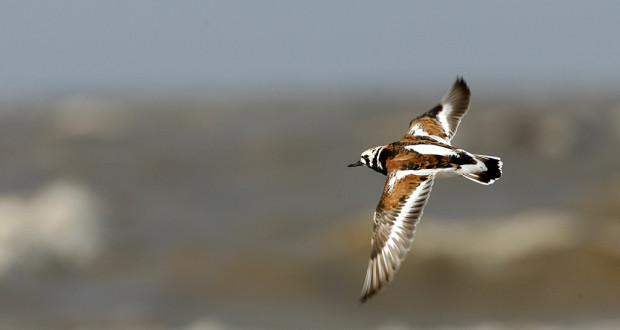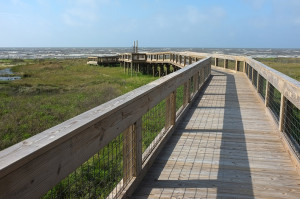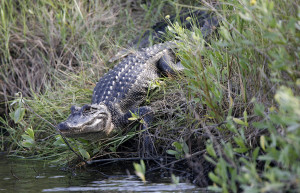Only stumps and concrete foundations are left from the original boardwalks, buildings and docks, but there is still access to five miles of open beach, dune grasses have reclaimed the area behind the beach, and a new long boardwalk bridge will soon be connected to the parking lot. A boat ramp offers access to the ponds, marsh and bayous on the north side of Highway 87, but few other structures are left on that side of the road.
If you ignore the facilities under construction, the beach and nearby wetlands still call birdwatchers, fisherman and beachcombers. Certainly, the birds don’t seem to mind the construction. On a recent day, Black-necked Stilts foraged among the wreckage of the hurricane, Dunlins and other shorebirds prodded the muddy pools by the parking lot, lines of Brown Pelicans soared along the waterfront, and a Great Egret walked the new boardwalk like it was home.
The 4,000 acres of Sea Rim Park are part of a string of natural spaces along Highway 87 that include Texas Point National Wildlife Refuge, the Sabine Woods Bird Sanctuary and McFaddin National Wildlife Refuge. Similar to its neighbors, Sea Rim attracts a variety of wildlife described here by the state parks department:
Located along the Greater Texas Coastal Birding Trail, Sea Rim State Park serves as a rest stop for many species of migratory birds traveling the Central Flyway. Warblers, swallows, vireos, grosbeaks, buntings and flycatchers are only a few of the birds that visitors can expect to see. American alligator, mink, nutria, raccoon, rabbit, opossum, skunk, river otter and muskrat are some of the many animals found in the park. At dawn and dusk, bobcats and coyotes can sometimes be seen. White and brown shrimp, crabs, and various sport fishes, such as red drum, speckled trout and flounder, thrive in the park’s lakes and bayous. Rich with plankton and organic matter, the marshland waters serve as a nursery for various species of aquatic life, supporting marine fisheries and migratory waterfowl.
From the last parking lot before you drive onto the beach, the Gambusia Nature Trail boardwalk loops through the grasses and marshland between the beach and the highway, where you may run across nesting birds.
The bulk of the park lies on the other side of the highway – 15,000 acres of wetlands that includes bayou, marshlands and several lakes and ponds that expand and contract with recent rainfall. In addition to wading birds and migratory waterfowl, they host a healthy population of alligators. Canoes, kayaks and small boats can launch from the boat ramp at the end of the road.
While Sea Rim continues its renovation, the McFaddin National Wildlife Refuge, which is just a short drive down the road, offers a nicer beach experience without the park fees.
PARK GALLERY











You must be logged in to post a comment.